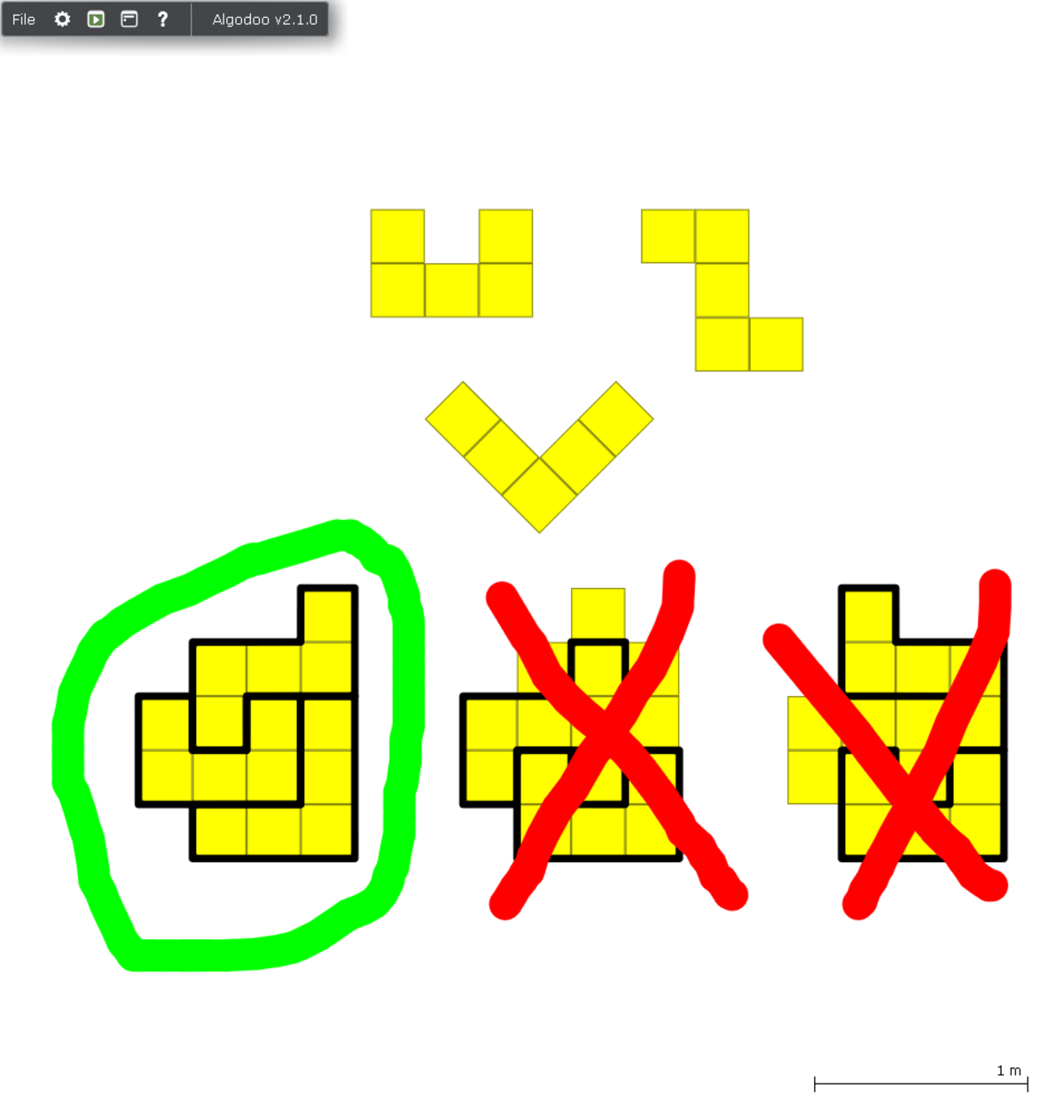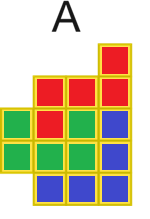60 of 100: Letters Assemble!
Using all three of the pentominoes above, they can be assembled into one of the shapes below (rotations and reflections are allowed). Which one?
It's possible to solve this using logic without having to do that many experiments!
This section requires Javascript.
You are seeing this because something didn't load right. We suggest you, (a) try
refreshing the page, (b) enabling javascript if it is disabled on your browser and,
finally, (c)
loading the
non-javascript version of this page
. We're sorry about the hassle.
12 solutions
super explanation with visual understandings!
Excellent presentation - I got as far as working out very quickly how to fit the three smaller shapes together to make A and therefore felt no need to rule the other two out as the question specified that precisely one of A B and C could be assembled from the smaller shapes.
Log in to reply
Thanks, my first solution was the same, just A:) I thought I'd add them for the sake of things.
For pattern C, your placement of the z piece doesn't force exactly that placement of the v piece. It could be reflected and shifted left. It would still cut the larger figure into two parts. I'm just saying your list of possibilities isn't exhaustive. Pattern C could be covered by the z piece as you place it along with two copies of the u piece. I'm tempted to say that this line of argument could be used to eliminate C.
Log in to reply
I think I came from the approach that the topmost piece must be filled, and the only way of doing so was as shown in the diagrams.
Log in to reply
The V piece can be rotated by 180 degrees, too. So there are three different approaches in case C, but all of them results in at least one smaller than 5-sized remaining piece.
Log in to reply
@Laszlo Kocsis – Of course, clearly should have seen that
b's v piece can also be in the bottom right corner touching the vertex of the v piece
The truth is that you can solve A just by looking :)
Rather than just try to find a solution, we can look at the different shapes and see if we can rule any of them out right away.
The easiest one is B. Looking at the one block that is sticking out at the top, we see that there isn't anything that can fill it in, so B can't be assembled using these pentominoes.
Looking at C, it shouldn't take long to convince yourself that there isn't a place to put the L-shaped pentomino that will leave room for the other two pentominoes.
The only one we haven't ruled out is A, and, through some trial and error, a solution can be found for it!
I thought of the same thing.
It is easy to notice that it is impossible to assembly figure B or figure C.
First thing that comes to mind is although not exclude some two options options but just assembly some figure by yourself, in your imagination , that also can be done due to small complexity of those figures.
That is a typical IQ test task.
So we either just solve it or we are not "gifted" enough.
This is not a solution but a comment. If you wish to comment, I recommend commenting on one of the solutions or not at all.
Log in to reply
Thanks I have added some solution related information to my post
As I can't comment on other solutions, I write it here (so excuse me). I would just to know what's the "using logic" solution that Brilliant staff had in mind when they wrote this problem. I find easy to manipulate the shapes in my mind to find that they fit in the first figure. But I don't know if there is some other "logical" approach to solve this kind of problems and that I'd be missing.
I wonder if we can find a way of describing the shapes algebraically. One method seems to be to describe each of the basic shapes possibly by a 3 x 3 matrix of ones and zeros, find some invariant property of each of these matrices, for example, the characteristic polynomial or the eigenvalues, find the characteristic polynomial of each of the candidate solutions & see if they could be derived from the polynomials of the basic motifs.
This is a tentative exploration of how algebraic and analytical methods could be used to solve such supposedly purely geometric problems. This problem may be solved through simple visualization but analytical / algebraic methods would be helpful when the problem is scaled up in complexity and / or when it is easy to make a mistake
One could look at symmetries but again, how the symmetries combine may be fairly involved
A simpler graph theoretical approach seems to be to look at the combined connectivities of the boundary squares of each of the basic shapes and see what remains invariant
One property that comes to mind is the convexity (or lack of it) of the figures

So A is the answer
Shape U requires no rotation or reflection.
Shape Z must be rotated 90 degrees clockwise, though no reflection is needed.
Shape V is rotated 45 degrees anti-clockwise, though no reflection is needed.
The only letter that the shapes can fit in is a.
Plate C is possible but you have to use U twice and without using V.
Plate B is not possible since there's one stud at the top.
Put U the way it is configured so that left two squares fit into left squares of A. Then fit Z on top of U by rotating it to the right 90 degrees counterclockwise. Finally rotate V counterclockwise 45 degrees and put it in the bottom and right squares of A which are below U and to the left U and Z.


A - Working Solution
B - Only possible approach leaves it unsolvable
C - Two possible approaches both leave the grid unsolvable